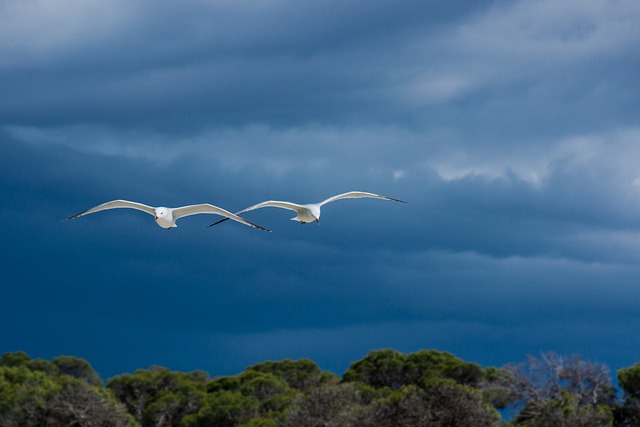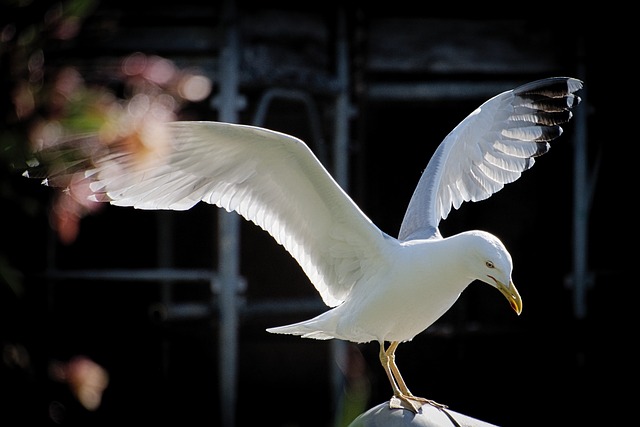Yes, many seagull species are known to fly at night, including the Swallow-tailed Gull which is adapted for nocturnal foraging.
Seagulls are mostly diurnal birds, which means they wake up at sunrise and rest at sunset. At sunset, gulls frequently congregate in large flocks before settling down to roost for the night. They rise early, often around 5 am during the summer or even later in the winter.
However, there exists an exception: the Swallow-tailed gull. This particular gull is unique in that it predominantly hunts at night and has a specialized diet comprising fish, plankton, and shellfish that are more active during the nighttime hours.
What Are The Seagull Diurnal Behavior?

Seagulls exhibit diurnal behavior, which means they are most active during the daylight hours. This behavior is tied to their visual adaptations and hunting strategies.
Moreover, Seagulls have well-developed vision optimized for daylight conditions, enabling them to spot prey such as fish and marine creatures more effectively when there is ample light.
In addition, their eyes are equipped with specialized photoreceptor cells that work best in bright environments, enhancing their ability to detect movement in water and on land.
Normal Daily Routine of Seagulls:
Activity at Sunrise and Sunset:
Seagulls typically become more active around sunrise, as this is the time when they engage in activities. Such as foraging for food, preening their feathers, and socializing with other gulls.
During sunset, they often congregate in large flocks, which can be observed near shorelines or on beaches. This behavior is thought to provide safety in numbers and protection against potential predators.
Gathering in Flocks Before Roosting:
Just before sunset, seagulls often gather in larger groups to roost for the night. This behavior serves several purposes. Moreover this behavior includes maintaining warmth through body heat exchange and exchanging information about safe roosting spots. Additionally, flocking also offers some protection against night-hunting predators.
Early Morning Wake-Up:
Seagulls are known for waking up early, usually around sunrise. This early start is attributed to their diurnal habits and the availability of food sources during daylight hours.
In addition, their activity starts with activities like stretching, preening, and engaging in brief vocalizations before they embark on their daily foraging routines.
What makes the Swallow-tailed Gull an exceptional or unique species?
In the world of avian wonders, the Swallow-tailed Gull emerges as a rare gem, captivating researchers with its nocturnal habits and unmistakably distinctive appearance
Unique Behavior of the Swallow-tailed Gull:
The Swallow-tailed gull stands out as an exception among seagulls due to its distinctive behavior. Unlike other gulls, the Swallow-tailed gull is known for its preference for nighttime activity. Moreover, this unique behavior allows it to exploit a specific ecological niche that centers around nocturnal hunting.
Nocturnal Feeding Habits:
The Swallow-tailed gull is primarily active at night, which is when it actively hunts for food. This behavior sets it apart from most other gulls that are diurnal.
In addition, the absence of competition from diurnal gulls during the nighttime hours gives the Swallow-tailed gull a significant advantage in accessing prey resources that are more active or abundant during the night.
Specialized Diet:
Fish, Plankton, and Shellfish:
The Swallow-tailed gull’s diet mainly consists of fish, plankton, and shellfish. These prey items are often more active and available during the night, aligning with the gull’s feeding habits.
Nighttime Activity of Prey:
Many fish and marine organisms exhibit increased activity during the night to avoid predators and to take advantage of lower light conditions. On the other hand, this nocturnal prey activity aligns perfectly with the feeding habits of the Swallow-tailed gull, allowing it to exploit food sources that might be overlooked by diurnal gulls.
How Are Their Napping Behavior and Daytime Activity?

Delving into the intriguing world of the Swallow-tailed Gull unveils a fascinating duality: its daytime slumber and mesmerizing nocturnal activities.
Napping Patterns Among Seagulls:
Naps Following Feeding Sessions:
Seagulls often take short naps after feeding sessions. This behavior allows them to digest their food more efficiently and conserve energy.
Hence, after actively foraging and consuming their meals, seagulls seek a safe and sheltered spot to rest. Napping after feeding helps them replenish energy stores while minimizing vulnerability to predators.
Daytime Napping During Migration:
During migration, seagulls might engage in daytime napping as they travel long distances. Migration requires substantial energy expenditure, and daytime naps allow them to rest without disrupting their migratory progress.
Moreover, these brief periods of rest aid in recuperation and help them maintain their strength for the journey ahead.
Adaptations for Diurnal Lifestyle:
Seagulls have evolved several adaptations that enhance their success in a diurnal lifestyle:
- Excellent Vision: Their eyes are designed to function optimally in daylight conditions, aiding in spotting prey from a distance.
- Color Vision: Seagulls have color vision, which assists in identifying food sources and assessing the environment accurately.
- Depth Perception: Binocular vision provides them with depth perception, crucial for accurately judging distances when diving for prey.
What Are The Factors Influencing Nighttime Activity?
Under the cover of darkness, the Swallow-tailed Gull’s enigmatic nighttime activities are shaped by a symphony of ecological and evolutionary factors.
Artificial Light Sources:
Artificial light sources can influence the nighttime activity of seagulls. Bright lights in urban areas or near fishing vessels might attract seagulls, as these sources can simulate daylight conditions.
Moreover, this can lead to altered behavior, with seagulls foraging at night near these artificial light sources.
Urban Environments:
Urban environments can disrupt the natural diurnal patterns of seagulls. City lights, noise, and human activity might discourage some seagulls from roosting at night.
Moreover it leads them to become more active during nighttime hours to scavenge for food in human-populated areas.
Food Availability:
The availability of food resources can play a significant role in seagulls’ nighttime activity. In some cases, food sources that are more active or accessible during the night might prompt certain gull species to adjust their behavior and forage nocturnally.
For instance, in coastal areas, tidal cycles might influence the abundance and activity of prey species, affecting when seagulls are most active.
FAQs
Do seagulls sleep on the water?
Seagulls often sleep on land, such as cliffs, rocks, or beaches, rather than on the water.
Do seagulls sleep while flying?
Seagulls do not sleep while flying they typically rest and sleep while perched on solid surfaces.
Do seagulls sleep in trees?
Seagulls usually do not sleep in trees; they prefer open areas near water for resting and sleeping.
Do seagulls have night vision?
Seagulls have better night vision than humans, which aids in their nocturnal activities like the Swallow-tailed gull’s feeding.
Where do seagulls sleep when it rains?
Seagulls often find sheltered spots on cliffs, buildings, or under vegetation to sleep during rainy weather.
Where do baby seagulls sleep?
Baby seagulls, or chicks, sleep close to their parents in nests or sheltered areas to stay protected.
Do seagulls sleep in the same place every night?
Seagulls may vary their roosting locations based on factors like food availability and safety from predators.
Conclusion
The behavior of seagulls, whether diurnal or nocturnal, reflects their remarkable adaptability to diverse environments and food sources. While most seagulls adhere to a diurnal lifestyle, characterized by activity at sunrise, roosting at sunset, and early morning wake-ups, the Swallow-tailed gull stands as a fascinating exception with its preference for nocturnal feeding habits and specialized diet.
Moreover, napping patterns among seagulls, such as post-feeding naps and daytime rests during migration, showcase their ability to balance energy conservation and activity demands.
In addition, these patterns highlight the importance of strategic rest to their overall survival and well-being.
Seagulls’ adaptations for a diurnal lifestyle, including exceptional vision, color perception, and depth awareness, have enabled them to excel in their roles as daytime foragers.
Additionally, their ability to adjust their behavior in response to artificial light sources, urban environments, and food availability underscores their flexibility in adapting to changing conditions.











